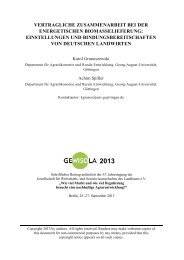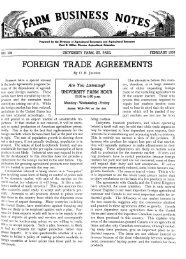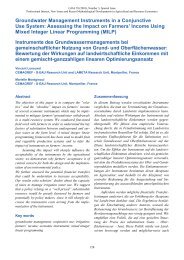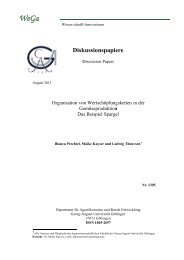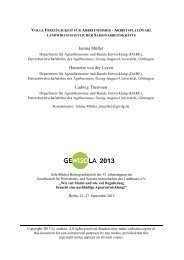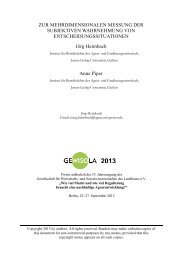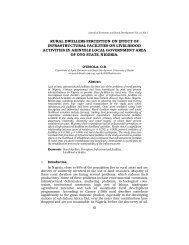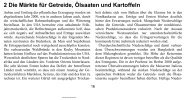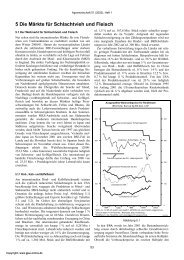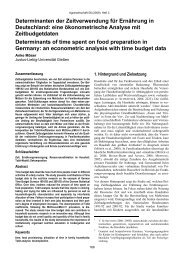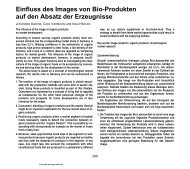View/Open - AgEcon Search
View/Open - AgEcon Search
View/Open - AgEcon Search
You also want an ePaper? Increase the reach of your titles
YUMPU automatically turns print PDFs into web optimized ePapers that Google loves.
Advertising, Promotion, and Competition:<br />
A Survey with Special Reference to Food<br />
By John M. Connor·<br />
Abstract<br />
Th,s article surveys the theoretICal and empmcal hterature on the economIcs of advertIsing during<br />
the last decade The survey notes several promlsmg advances 10 theoretIcal modehng of the role<br />
of advertisIng 10 consumer choice and sOCIal welfare Numerous empmcal investigations of food<br />
and other consumer products have estabhshed relationshIps between advertising and market structure<br />
or performance mdlcators Less progress was found on selected SOCioeconomiC adverbsmg<br />
Issues that are dIfficult for tradJtlonal economIcs to handle<br />
Keywords<br />
AdvertISing, Sales promotion, Market structure, Performance, Welfare economiCS, Consumer<br />
chOice<br />
Introduction<br />
The study of the economIc role of advertiSing began only 30<br />
years ago WIth a seminal paper by Kaldor (14) 1 AnalytIc<br />
modehng of advertlsmg and related forms of sales promotion<br />
has proved arduous and nearly Intractable The first crude<br />
empmcal tests of hypotheses about advertISing began only<br />
15 years ago Dunng the last 10 years, substantial progress<br />
has been made In both the theoretical and empmcal economIc<br />
literature,<br />
In thIS article, I survey recent analyses of the economIc role<br />
of adverbsmg and other types of sales efforts, fOCUSing<br />
especIally on the socIoeconomIc and welfare effects of advertising<br />
I consIder the role of adverbslng In determining the<br />
quality of competition m markets for food and other grocery<br />
products, The most recent survey of the welfare effects of<br />
advertlsmg IS an article by Doyle (10), wrItten In 1968<br />
Shaffer has also thoroughly surveyed the role of advertISIng<br />
In food marketing firms (38) However, both articles are 10<br />
part dated<br />
After exanunmg the conventIonal distinction between<br />
advertISIng as Information and advertiSing as persuasion, I<br />
discuss several SOCioeconomiC Issues surroundmg advertIsmg<br />
and survey the eVIdence regardJng five separate welfare<br />
economIcs ISSues [conclude by assessmg the hterature and<br />
making suggestIOns for future research<br />
·The author IS an economist WIth the National Economics<br />
DIVISion, EBB<br />
1ItaliCized numbers In l?arentheses refer to Items lD the<br />
references at the end of thl8 article<br />
Information versus Persuasion<br />
SeUers differentIate thell products from those of rival sellers<br />
in four main ways space, fonn, semce, and unage Spatial<br />
dJfferentlatlon occurs through selecbog convement plant or<br />
store locations Form dJffenmtlatlon occurs when products<br />
are altered phySIcally to create differences ID shape, navor,<br />
color, durability, storabdlty, IngredJents, or packagmg Service<br />
differentiatlon',s common In retad trade or In a product<br />
that requires rep8lrs during its usable Iife_ Image dIfferentiation<br />
involves the sublectlve ImpressIons of consumers about a<br />
particular product, such as the kind of person who typIcally<br />
uses that product_ Image dIfferentiation often occurs 10<br />
conJuncbon With one or more of the other three kmds of<br />
dJfferentlatlOn Labeling, packagmg, and advertISIng are the<br />
pnnclpal means of Image differentiatIOn of products 2<br />
It IS true that some, perhaps most, adverbsmg proVIdes mformatlon<br />
about the tangible, oblectlve charactenstlcs of products<br />
or serviceS offered for sale, facts that aid buyers In<br />
conSCIOUS, rational declslonmakmg InformatIonal cues on<br />
Ingredients, durablhty, pomts of purchase, and price are<br />
charactenstlcs of classIfied advertlsmg, trade pubhcatlons,<br />
and catalogs. However, much advertiSIng content appears<br />
to be pnmanly "persuasIve" messages that are hIghly sub<br />
Jective, emotive, or even subconSCIOus In theu appeal Most<br />
adverbslng through the mass medJa (partIcularly the elec<br />
2Enterpnses can also create Images whIch affect their<br />
product or servtce offenngs Enterpnse dIfferentiatIOn<br />
occurs mainly through spatial or serVIce differentiation<br />
Food retatlers~ for example, employ store decor or color<br />
schemes, checK-cashmg seroces, nutnbon counsehng) unique<br />
private-label products, and other deVICes to differentiate theIr<br />
ente!pnses DiversIfied food manufacturers, In contrast<br />
usually offer a multipliCIty of brands that dISCourages the<br />
development of a companY·Wlde consumer unage<br />
AGRICULTURAL ECONOMICS RESEARCHI VOL 33, NO 1, JANUARY 1981 19
tromc medIa) IS preponderantly persuasIve Other massmedls<br />
advertising contaInS a more equal mlXture of mfor·<br />
mative and persuasive elements, newspapers, billboards, and<br />
magazmes are often of thIS type (35) Some forms of sale,<br />
promotIOn are largely persuasive (coupons, sweepstakes. and<br />
mcentIves), whereas others are partly mformatlve (free<br />
samples and sales demonstratIons)<br />
The proportion of mformatIon contaIned In advertIsmg<br />
vanes not only by medIUm but also by type of product_<br />
Some products have been assocIated WIth hIstorIcally Intense<br />
and uninformative advertiSing [terns relatmg to personal<br />
care (razors, soaps, and deodorants) are suscepbble to adver·<br />
tlsements emphaslzmg the product's abIlIty to reduce feehngs<br />
of personal msecunty The advertlsmg of lUXury products,<br />
like perfumes, furs, or Jewelry, IS onented toward lDcreasmg<br />
SOCIal status Some foods and beverages have lost theIr function<br />
as necessIties or sources of nutntIon alone "Dietetic"<br />
foods and chewmg gum, for example, are valued less for<br />
theIr hfe-sustamlng attrIbutes than for thell organoleptIc<br />
properties Many foods are consumed In 8 CODVlVlal or<br />
ceremomal settmg and are thus more prone to hIghly persua<br />
Sive advertiSing There IS 8 world of difference between a<br />
sack of flour and a bottle of champagne 10 theIr potentIal<br />
for bemg Image-dIfferentIated<br />
Most packaged and branded grocery Items have properties<br />
that lend themselves to substanbal adverbsmg expenditures<br />
relatIve to sales One of the most comprehenSIve studIes<br />
of the determmants of advertlSlng IntenSIty was recenUy<br />
pubhshed by FarrIS and Buzzell (11) Based on the lOternal<br />
records of 281 consumer hnes of bUSiness, ,they found that<br />
the ratio of advertlsmg and promotion expendItures 3 to sales<br />
was posItively and Significantly related to standardizatIOn<br />
(not speclal-ordered), mfrequency of purchase, small umtpurchase<br />
value, proportIon of sales to dlstnbutors (as<br />
opposed to dIrect sales to final consumers), and proportIOn<br />
of new products marketed by the busmess Except for Infrequency<br />
of purehase, all these charactenstICs are tyPICal<br />
of packaged, branded grocery products Consequently, the<br />
advertISIng mtenSlty of processed food and tobacco products<br />
IS relatIvely hIgh Media adverbsmg by food manufacturers<br />
alone averages well over 3 percent of sales If one<br />
excludes hIghly penshable products, food retaIlers spend an<br />
addlhonal 1 percent of their sales on advertlsmg (7) Other<br />
3These expenditures Included media advertlsmg, catalogs,<br />
exhibits, premiums, coupons, free samples, and special<br />
promotlOnal discounts The costs of field sales forces were<br />
not Included<br />
fonns of sales promotion such as coupons, mcentIves,<br />
samples, and some dIrect sales force actlVlty would probably<br />
raISe the mtenSlty of advertlSmg to 8 percent of sales<br />
The InformatIve content of advertISIng IS at the heart of<br />
diSCUSSions on the SOCial and economic value of advertJsmg<br />
Theones of adverbslOg developed by StIgler (41), Telser<br />
(43), and Nelson (22) assume that consumer expenence WIth<br />
a product should eIther remforee correct prepurchase mformatIon<br />
or mvalldate false mformatlon The market wIll<br />
ImmedIately dlsclphne all false advertismg through a loss of<br />
market share to sellers Moreover, these theoretical models<br />
conclude that firms with unknown products and those offer<br />
Ing the best qualIty/prIce combmatIon are the ones that<br />
advertISe most WIth purely factual or mformatIve advertlSmg,<br />
the effects of advertISIng are umformly welfareenhanCIng<br />
Consumer search costs would be SIgnIficantly<br />
lower With mfonnatlve mass adverhsmg than With searches<br />
mvolvIng mdlVldual tnal consumptIon or testing As sellers<br />
have no IncentIve to deceIve WIth advertISIng, the StIgler<br />
Telser-Nelson models Imply that competItIve market performance<br />
IS enhanced If consumers Simply choose the most<br />
heaVIly advertIsed products<br />
LIttle empmcal eVIdence exISts on the mformatlve content of<br />
advertlsmg, but one Imtlal effort mdlcates very low levels for<br />
teleVISIon advertlSmg 4 Resmk and Stern (31) examIned 378<br />
randomly selected teleVISIon commercIals (78 percent of<br />
whIch were grocery products) for 14 dIfferent informatIonal<br />
cues Only 45 percent of the commercials for grocery products<br />
contamed even one mtonnatlonal cue, the rest were<br />
deVOid of Informative content Prehmmary results of research<br />
by the same authors on other medIa IndIcate a hIgher proportIon<br />
of mformatlve adverusements EmPIriCal eVIdence<br />
combmed With more recent theones cast some doubt on the<br />
sangume conclUSIOns of the StIgler-Telser-Nelson research.<br />
More recent models generally assume that consumers cannot<br />
costlessly and ImmedIately vahdate the qualIty of a purchased<br />
product WIth absolute certamty Kotowltz and<br />
4Parker and Connor (26) calculated that In 1975 approxImately<br />
one-fifth of all mass-media advertlBlDg expenditures<br />
for all (SIC 20) manufactured foods was "excesslve"-that lB,<br />
nomnfonnatlve Their method, admittedly huddy conJectural,<br />
diVided the 130 food product classes Into those that<br />
were competitive and those that dId not meet the competitive<br />
concentration standard (40 percent four-firm seller concentration<br />
ratio or less) They then calculated the mformatl've<br />
advertlsmg-to.sa]es ratIo for 'hoae c1..... (0 53 percent) and<br />
netted that amount from all other product classes The<br />
remaInder was conSidered excessive KaIdor (14) IDdepen~<br />
tiently arrived at a slJ1ular mformatlOn proportion of advertlsmg<br />
costs<br />
20
The mformatlVe content of adr;erhsmg IS at the heart of<br />
dJScuss,ons on the soeml and economIC value of advertISing<br />
Mathewson (15) have mvestIgated the relatIonshIp between<br />
"correct" (nondeceptIve) advertIsing and monopoly Their<br />
theoretIcal model assumes the eKlstence of a nondlscnmmat<br />
Ing monopohst and consumers whose consumptIon IS<br />
affected posItIvely by the consumptIon of other consumers<br />
(the "demonstration" effect). Under these conditions, the<br />
equlhbrlUm result IS that the seller expends more than the<br />
socIally optimal amount on advertISIng and SImultaneously<br />
provIdes too little total 10 formatIOn to consumers ThIS<br />
model demonstrates a key hnk between advertismg, mformatIve<br />
content, and the welfare erfects of Imperfect competItIon<br />
When consumers are imperfectly mformed about products,<br />
the market does not maxUnlze SOCIal welfare Smallwood and<br />
Conllsk (39) have presented a model 10 whIch consumers<br />
know the pnce of products and the pnces of all brands are<br />
held equal, but consumers are uncertain about product qualIty<br />
untIl use (tbat IS, mspectlOn pllor to consumptIon cannot<br />
reveal quality, as IS true of most packaged consumer goods)<br />
Smallwood and Conhsk's model, budt on an adaptive dynamIC<br />
searcb strategy, results ID alternative eqUlhbna, two of whIch<br />
are InterestIng FIrst, even though pnces are the same, eqUlhbna<br />
eKlst for which several dIfferent qualIty I"vels of products<br />
sUrvive 10 the market Second, It Is pOSSIble, under some<br />
reasonable conditions, for a brand of "mferior" quality With<br />
an InitIally hIgh market share to capture the entIre market<br />
over bme<br />
A second artIcle by Kotowltz and Mathewson (16) IS also<br />
based on a consumer adapt,ve-search strategy Their model<br />
assumes that (1) rational consumers are Ignorant, but tractable,<br />
about product qualIty, (2) tastes are formed and fixed<br />
with respect to product attnbutes; and (3) advertISIng does<br />
not alter tastes, but does alter perceptIOns about a qualIty<br />
attnbute that reqUIres continuous, prolonged expenence to<br />
evaluate In thiS model, while false advertiSing claims are<br />
eventually mvalldated, the speed of dIScovery depends on the<br />
consumer's ablhty to learn and remember It can be profitable<br />
In the long run for 8 monopolist to mislead consumers,<br />
at least for a penod of bme, by glvmg them mcorrect qualIty<br />
mformatIon Although the authors cannot make any unambiguous<br />
welfare conclUSions for margmal consumers, all mframarginal<br />
consumers expenence a loss because the monopolist<br />
substItutes adverbsmg clBlms about product qualIty for true<br />
quality<br />
Unresolved Issues<br />
There are several Issues related to the perceived SOCial erfects<br />
of advertlSmg Some he outsIde the tradItIonal domalD of<br />
economICS The rest are baSIcally unresearched questIOns In<br />
general, less progress can be cited m setthng these Issues than<br />
the welfare economics issues I diSCUSS later However, the<br />
tOPICS are suffiCIently Important to be conSIdered here<br />
First, It IS sometImes cl81med that advertIsmg Increases macroeconomIc<br />
stability because of countercychcal adverbsmg<br />
expendItures by sellers and the resultmg stabilIzatIon of<br />
consumer aspirations over time Scherer's (36) survey of thiS<br />
Issue finds that adverbsmg expenditures show a deflmte<br />
procychcal pattern Moreover, empirical studIes of the effects<br />
of adverbsmg on aggregate consumption have YIelded mconslstent<br />
results Thus, the eVidence on dynamiC stabilizatIOn IS<br />
mconcluslve.<br />
Second, some of the "mfonnatIon It conveyed by advertiSIng<br />
IS deceptIve or at least IDlsleadmg m a legal sense_ There are<br />
voluntary US mdustry groups whose regulations hmlt<br />
deceptIons, such as the NatIonal AdvertlSmg RevIew Board<br />
State and Federal Government agencIes enforce laws agBlnst<br />
deceptIve and fraudulant advertISIng clBlms Although these<br />
efforts have largely ehlDlnated blatant deceptIOn, omISSIOn of<br />
relevant facts, innuendo, obvIOUS exaggeratIOn, and puffery<br />
are typICal features of modem advertlslng Preston's book on<br />
puffery (29) CItes scores of examples of food advertIsements<br />
contmmng puffery statements lIke "Milwaukee's finest beer,"<br />
"the biggest lIttle treat In all the land," and "every body<br />
needs mIlk" Sucb phrasmg IS not Illegal, but Preston argues<br />
that It may mISlead some consumers and must have some<br />
effect on purchaslDg patterns At least, the frequency WIth<br />
which such seemingly irrefutable phrases appear in advertlSlDg<br />
copy arouses cynicism among some sellers and consumers<br />
about the truthfulness of advertising (36, p_ 3S0)<br />
Third, advertising IS critiCIzed sometimes for IDstilling or<br />
entrenchmg hedomstic values Food advertISIng, for example,<br />
often OlDlts facts about health or nutritIOn but<br />
Includes assertions about sensual characteristics Some<br />
cntics perceive a connection between the rise of hedOnism<br />
and the appearance of modern advertiSing In Western societies<br />
Yet counter-examples also abound (wartime exhortatIOns,<br />
antlSmokmg campaIgns), and SCltovSky (37) has woven an<br />
elegant argument that, despIte hIgh levels of advertlSlDg, U S<br />
consumers habItually underachIeve 10 pleasure-seekmg relabve<br />
to cItizens of other countnes<br />
Fourth, adverbslDg may substantIally arrect natIonal food<br />
chOIce By raISIng pnces on heaVIly advertIsed products,<br />
many consumers are forced to SUbstitute less deSirable brands<br />
10 the same product category AdvertlSmg probably shIfts<br />
21
mtenndustry demand as well as mterbrand demand In the<br />
long run AdvertISing may be partially responsible for the<br />
notable shift m preference away from milk, frwt JUIces,<br />
and water (which are less adverbsed) to artificially fruitflavored<br />
dnnks, soft dnnks, tea, and alcohohc beverag~s<br />
(all of which are heaVily advertised) Indeed, Mottern (19)<br />
has presented some eVidence suggestmg an association between<br />
heavy advertlsmg and poor nutfitlOnal charactenstIcs of<br />
foods<br />
Finally, there IS the questIOn of Interdependent utlhty<br />
functions Much advertlsmg seeks to lead consumers to<br />
compare thell own well-bemg with that of other consumers,<br />
It urges them to emulate the consumptIOn patterns of those<br />
they admire Consumer utlhty thereby depends on others'<br />
perceived consumption habits as well ~ on the mtnnslc<br />
charactenstlcs of the products or servIces, thus generatmg<br />
external effects m consumption Thus, some advertlsmg first<br />
creates dISSatISfaction In potential consumers which can<br />
only be removed by purchasing the advertised commodity,<br />
bnnglng consumers back to thm onglnal level of satisfactIOn<br />
(pnor to the assault on their preference structure by the<br />
advertlsmg) It IS doubtful that advertlsmg which contams<br />
only messages of status discontent can ever result In a net<br />
mcrease m consumer satisfaction<br />
Issues of Welfare Economics<br />
Doyle (10) has Identified five maJor,lssues of welfare economics<br />
mvolvmg commercial advertIsmg, especially the<br />
persuasive kind<br />
1 Its relationship to monopoly market sJructu!es,<br />
espeCially barners to entry, and concentratIOn,<br />
2 Its Impact on profits, prIces, market share stability,<br />
and other Indicators of market power,<br />
3 Whether It stimulates or retards technological<br />
progress,<br />
4 Its relationship to guarantees of product qUality,<br />
5 The extent to which It cross-subSidizes the entertamment<br />
media<br />
Market Structure<br />
Here we conSIder the relationships of adverbsmg and promotIOn<br />
to concentratIOn, economies of scale, and other bamers<br />
to entry EmplncaJ tests of relatIOnships have frequently<br />
used the ratio of media advertlsmg to sales as a proxy for the<br />
degree of product differentiatIOn, assuming that other sales<br />
promobon efforts are correlated With advertosmg The advertising-concentration<br />
relationship IS one of the oldest and<br />
most frequently exarmned tOPICS m mdustnal organizatIon<br />
research A recent survey by Coman or and Wilson (5) concluded<br />
th.t the dllecbon of causality depends on the samples<br />
or bme penod studied A recent test by Ward and Behr<br />
(44) found a strong positive relatIOnshIp for consumer nondurable<br />
mdustrles In several tIme'penods, an exarrunauon'of<br />
the food'mdustnes f.lled to find any rufferenee from'the<br />
consumer nondurable Industnes USing a slmultaneousequatIons<br />
model of structure and performance In the food<br />
manufactunng mdustnes 10 1967 and 1972, Pagoulatos and<br />
Sorenson discovered that advertiSing intensity was strongly<br />
and pOSItively associated WIth market concentratIOn (25)<br />
Analyses of concentratIOn and advertlsmg mtenslty are IDcomplete<br />
m mdlCatmg the level of competItion because the<br />
level also depends on the eXistence of nonadvertISIng barners<br />
to entry<br />
Advertlsmg may be related to another element of market<br />
structure--economles of sca1e m production It has been<br />
agrued that adverbsmg expands a firm's sales and thereby<br />
allows attamment of the optimal scale of production Neither<br />
Scherer (35) nor Doyle (10) beheves there IS any emplDcal<br />
eVIdence for thiS hypotheSIs, mdeed, gIven that adverbsmg<br />
mtenslty IS related to phYSIcal product dlfferenbab~n,<br />
numerous product vanebes, planned obsolescence, and consequent<br />
short production runs, the reverse IS lIkely true<br />
Connor (6) has establIshed that brand prohferabon among<br />
processed foods 15 Significantly and directly related to media<br />
advertlsmg mtenslty However, these findIngs ~er,!r to'smgleplant<br />
economIes, It IS pOSSIble that advertlsmg and promotIOn<br />
may give nse either,to pecumary advantages to size or<br />
to multiplant economies of scale Scherer arid others suggest<br />
that, for two grocery-products mdustnes, optlm~ US<br />
multIplant scales are reached at the two- to five-plant level<br />
due to advertlsmg and Image differentIation alone<br />
Most research pomts to substantial econoDlles of scale<br />
In advertiSing Itself That IS, as the amounts of advertIsmg<br />
and promotion mputs In a finn are Increased proportIonately<br />
With other productIOn and marketmg mputs, output (sales)<br />
mcreases more than proportIonately over a certaJn range<br />
Strong eVidence eXIsts for substantIal economies of sca1e for<br />
beer (27) and cigarettes (2) 5 For a large sample of consumerproduct<br />
hnes of busmess, Fams and Buzzell (11) found that<br />
market share was mversely related to the Intensity of adver<br />
5 AdvertIsmg capital IS used In these studies For foods<br />
and most consumer nondurables, annual depreclillion I.ltt'~<br />
were found to be ID the range of 30-80 perc('nl<br />
22
The aVallable eVIdence supports the hypothesIS that hIgh<br />
advertJSlng mtenslty leads to above-normal profits m food<br />
manufacturmg, however, comparable studies are not<br />
avaIlable for other stages of the food markehng system<br />
tlslng, even after controlling for several other factors The<br />
Nielsen Researcher (24) found that brand market share and<br />
brand advertising share were pOSItIvely and closely correlated<br />
for 60 grocery store brands In 20 product classes, however,<br />
except for brands With a low-pnce image, advertiSIng share<br />
tended to exceed market share Economies of scale In advertISing<br />
anse from two pnnclpal sources pecuDiary and technolOgical<br />
economies (4) First, volume discounts appear to<br />
persISt for specific kinds of media advertising, particularly<br />
the electromc medIa and national magazInes Also, some<br />
media events-for example, the Olymplcs-are lumpy (infrequent<br />
and unusual), which can give advantages to the<br />
leading firms In an Industry when bidding for chOice advertIsing<br />
slots Second, advertISing effectIveness (the number<br />
of messages of equal buyer Impact) may be less expensive<br />
at larger volumes than amaller SometImes thiS effectiveness<br />
can be attnbuted to the use of national rather than local<br />
media, to the eXistence of a threshold effect In advertIsmg,<br />
or to the advantages of haVing a "full line" of products over<br />
wluch the advertISIng of a hmlted number of brand names<br />
can be spread<br />
Economies of scale lD advertlslDg Imply substantial barners<br />
to entry by small firms Their successful entry Will reqwre<br />
much higher advertlSlDg-to-saies ratIos initIally than those for<br />
the established firms lD a market, the costs may be so high<br />
that entry IS unprofitable for months or years Moreover,<br />
mtroducing one brand moo a consumer goods market on a<br />
national scale may require an initIal advertlsmg Bnd promotIon<br />
budget of several mllhon dollars (7) Fmanclal mstItutIons<br />
wlll not usually lend a newcomer funds for thIS purpose,<br />
hence, new-product launches can constItute an absolute<br />
capIW barner to entry_ Large or diversified firms are the<br />
pnnclpal sources of new food products, and their relative<br />
ease In overcomIng promotIonal entry bamers IS doubtless<br />
one of the reasons (6)<br />
The general conclUSion about advertiSing as a cause of high<br />
entry barners must be modified for retall and semce operations<br />
(4, 35) ThIS qualification rests malDly on research<br />
companng pnces and quahty of optometry semces across<br />
CitIes With different rules govemlDg advertlsmg Poces are<br />
Significantly lower 10 areas permitting advertISIng, whereas<br />
few differences eXISted 10 the quahty of the goods and ser<br />
Vices (I) Thus, advertiSing by food reWlers may IIld entry,<br />
but there are as yet no speCific studies on thIS subject<br />
Ultimately, the most Important Impact of advertising on competitIOn<br />
may be on the longrun alteratIon of market structures<br />
In one detruled study, Mueller and Rogers exammed<br />
the relatIOnship of advertlsmg to changes In seller concentratIOn<br />
10 the U S manufacturing mdustnes (21) Recently<br />
rephcated for the food mdustnes by Rogers (32), these results<br />
indICate that, ceterIS paribus, intenSive advertlSlng (especially<br />
on radiO and teleVISIOn) caused concentratIOn to lise over<br />
the 1958-72 penod Without advertiSing, "natural" compet<br />
ItIve forces would have eroded market concentratJon Mather's<br />
stody In 1979 proVidessome inSight Into one type of conduct<br />
associated With concentratIon change (18) Ills study of 68<br />
mergers of food firms dunng the 1967-76 penod confirms<br />
that advertiSing expenditures rose more than 50 percent In<br />
the 2 years follOWing the merger, especially after productextensIOn<br />
type mergers Taken together, these last two studies<br />
suggest why conglomerate mergers IDvolvmg consumer goods<br />
firms may restructure markets<br />
PrIce and ProfIt Performance<br />
AdvertiSing lDtenslty, while not an entirely satISfactory<br />
proxy, has been used to represent the extent of product<br />
differentiation 10 a market It IS also assOCiated With basiC<br />
product charactenstlcs, such as durablllty, consumer versus<br />
producer goods dlstmctIon, mdustry media ChOIces, and<br />
manufacturer-retaIler power relatIonships The most ngorous<br />
studies mdlcate that both brand and Industry pnce elastIcItIes<br />
of demand are lowered by advertiSing That is, advertISing<br />
creates consumer loyalty, remforces repeat-purchasing<br />
patterns, and allows firms to rruse pnces (wlthm hmlts) relative<br />
to those of nvals With little erosIOn of sales_ Over tIme<br />
nval firms may respond With advertiSing campaigns of their<br />
own to preserve their share of the market and mlllntam their<br />
profits_ In an oligopohstIc market,· strategic consideratIOns<br />
lead to 8 SituatIOn in which firm advertlsmg expenditures are<br />
made largely to cancel out nval adverbslDg messages Under<br />
pure monopoly or perfectly coordmated, Jomt·profit maxlnuzatJon,<br />
total advertJsmg expenditures would be much<br />
lower than 10 a loose oligopoly (35) Some of these con<br />
Siderations may underhe the voluntary adverbsmg restnctions<br />
ID some mdustnes, such as the U S liquor mdustly<br />
FIrm or brand loyalty combmed With effective market-entry<br />
bamers can Insulate firms from competIbon The eXIStence<br />
of market power can be mferred from studies showmg that<br />
high profits an! pOSitively and Significantly related to concentratIon,<br />
advertiSing, and other market structure dlmenslons_<br />
Many such "profits-structure" studies have been performed<br />
for the manufacturing mdustnes, four of these have exammed<br />
the advertlsmg-profits relatIOnship for the food manufacturing<br />
60ne In which 8 few sellers dominate<br />
23
mdustnes Parker and Connor,(26) found that advertlsmg<br />
mtenslty had sIgnificant, pOSItIVe effects on the 47 food<br />
lOdust"es' pnce-cost margins for 1972 Vsmg 1950-54 data,<br />
the Federal Trade CommISSIOn (FTC) (12) found the same<br />
strong relationshIp from the 97 largest food manufactunng<br />
firms Vsmg 1967-72 data, Rogers (33) replicated these results<br />
for a SImIlar sample of 60 firms A fourth preilmmary study,<br />
USing a Simultaneous equatIon model, estimated a Significant,<br />
POSitive Impact of advertiSing and concentratIon on profits<br />
for the food processmg lOdustnes 10 1967 and 1972 (25)<br />
The avadable evIdence supports the hypotheSIs that hIgh<br />
advertlsmg mtenslty leads to above-nonnal profits 10 food<br />
manufactunng. however, comparable studies are not aV81lable<br />
for other stages of the food marketing system 7 These strong<br />
results are consistent With an Important analysIs by Porter<br />
that found that both the concentratIOn-profits and advertlSlngprofits<br />
relatIOnshIps were strongly pOSItIVe In those manufactunng<br />
mdustnes marketmg thell products through self-semce<br />
stores ilke grocery stores (28)<br />
By confemng market power on finns, advertlsmg should<br />
lead to hIgher pnces 10 the affected markets PrIce enhancement<br />
has tradItionally been more dIfficult to establish<br />
because appropnate pnce data are lackIDg However, one<br />
empmcal test relates the 1976 pnces of a large sample of<br />
advertIsed processed foods to market structure and other<br />
factors, the standards of companson were the pnces of eqwvalent<br />
pnvate-Iabel foods, whIch were assumed to be produced<br />
by sellers and dlstnbuted through channels deVOid of market<br />
power (26) Results showed that, cetens panbus, medIa<br />
advertiSing intensity had 8 Significant, poslbve Impact on<br />
wholesale pnces, for each 1-percent Increase In the advertlsmg-to-sales<br />
ratIO, wholesale pnces rose about 0 9 percent<br />
Furthennore, the proportIon of network teleVISIon advertlsmg<br />
relative to total elght-medlB expendItures had a slgmficant,<br />
positive Impact on prices On average, processed,<br />
branded food pnces were apprOXImately 8 5 percent hIgher<br />
than pnvate label equIvalents because of med,a advertiSIng<br />
alone 8 ThIS IS conSIderably less than the pnce differentials<br />
for speCIfic, hIghly advertISed, hIgh market-share grocery<br />
7The FTC study found that profits on assets were rwed<br />
by about 1 1 percentalle POints for each 1-percent mcrease m<br />
advertlslng-to-saJes ratio Rogers' results were about 1 5<br />
pomts on w;sets, Pagoulatos and Sorensen calculated a lIto<br />
1 O-percentage pomt Increase In sales, whereas Parker and<br />
Connor's results were 2 9 percentage POints of sales These<br />
elastiCities were calculated at the approxunate mean values<br />
for the advertlslng-to-sales ratlos<br />
8 Average four-film media advertunng-to-sales ratios were<br />
2 7 percent, and the average network TV proportion was<br />
o 35 percent (26, table 3)<br />
products CIted by Scherer (35) 9 It IS more than the 2-percent<br />
dIfferential to all coilsumer produce reckoned by Doyle (10)<br />
S,milar studIes of retall grocery pnces have not conSIdered<br />
the effects of retader advertlSmg on pnces SpatIal and<br />
semce differentiatIOn (Wide msles, modem stores, and 10<br />
store delicatessens) are probably more Important deter<br />
Illlnants of store-ta-store pnce differences Wlthm SIngle<br />
markets (17)<br />
Market share mobIlity IS an mdlcator of mdustry performance<br />
Generally, data on market-share changes are difficult<br />
to obtam, when employed, they should be confined to a<br />
smgle market and should represent a total finn's share of the<br />
market VslOg reliable data, Reelue found that market share<br />
mstablllty among 34 finely defined, food product classes was<br />
SIgnIficantly and pOSItIVely related to advertlsmg mtenslty<br />
(30) ThIS study's results are contrary to all the other findings<br />
on profit and pnce perfonnance quoted above, but because<br />
Reelue used brands rather than finn shares and failed to control<br />
for new product mtroductlons, the findings should be<br />
venfied WIth others before bemg accepted<br />
TechnolOgical ProgressIveness<br />
The concensus of the most recent, ngorous em pineal studIes<br />
of technolOgical progressIveness IS that a low to moderate<br />
amount of market power optimIzes the rate of progress (35)<br />
These studIes typIcally measured technolOgical output by<br />
research and development (R & D) expendItures (really an<br />
"lOput" measure), patent awards, SCientific publlcatlons<br />
by employees, or simllar measures Moderate finn Size and<br />
some degree of market concentration are held to reduce the<br />
nsk assOCIated WIth returns to R&D effort, these factors<br />
may also enhance a finn's cash flow, part of whIch can be<br />
d,verted to R&D uses Of course, factors other than market<br />
structure, such as technolOgical opportUnity, also playa role<br />
ln detemllnmg technolOgIcal advancement<br />
To the extent that advertISIng reduces unpredIctabIlity m a<br />
finn's market envIronment, It may also encourage technolOgical<br />
output, espeCIally advemsmg assOCIated WIth the<br />
mtroductlon of new products (35) Doyle (l0) argues that<br />
nonadvertIsmg factors are stronger mfluences over aU<br />
Only one empmcal study IS available on the progresslVenessadvemSlng<br />
relatlonslllp for food manufactunng finns<br />
Mueller, Culbertson, and Peckham (20) used IDdlVldual finn<br />
data from two penods, 1950-56 and 1967-74 They employed<br />
three measures of progresSIveness R&D expendItures, R&D<br />
9The examples mentIoned by Scherer Include, Realemon<br />
(30 percent hlgher), Clorox bleach (45 percent), and B study<br />
of 217 drugs (67 percent h,gher)<br />
24<br />
•
Results showed IfuJt medUJ advertISIng mtenslty fuJd.<br />
slgruflcant, posItive Impact on wholesale pnces, (or each<br />
I-percent mcrease In the adverttsmg-to-sales rotlO,<br />
wholesale prices rose about 0 9 percent<br />
employment, and patent output Their results showed that<br />
the advertIsIng-to-sales rabo had a signIficant, posItive Innuence<br />
on progressiveness In the latter penod, for patent<br />
output, advertlsmg mtenslty peaked at about 7 percent As<br />
expected, firm Size, dIVersificatIOn, and concentration w;ere<br />
consIstently sIgnIficant factors, firms wIth about $125-$150<br />
mllhon total assets (1967 dollar value) had the hIghest rate<br />
of techmcal output<br />
Product QualIty<br />
Some Image differentiatIOn may be necessary to motivate<br />
manufacturers or dlstnhutors of consumer goods to mruntam<br />
adequate quahty standards Slmple'trademarklng or labehng<br />
may be sufficient to ensure mIn}mal quahty standards for<br />
repetitively purchased goods (35) But mere brand IdentIfication<br />
or frumiaanty require only minimal levels of advertISIng<br />
or sales promotion Whether consumers can use heavy promotIOn<br />
as a guIde to hIgh qualIty products IS senously doubted<br />
by most economIsts (10) No doubt, for some products,<br />
many consumers use heavy advert~slOg as well as high pnces<br />
as a Sign of high quahty Double-blind expenments of some<br />
food products h~ve shown that consumers usually cannot<br />
distinguish average-priced from premlum-pnced Items (35,<br />
p 382) Thus, their wllhngness to pay hIgher pnces for more<br />
expensive equivalents IS apparent1y due to the aura, Image, or<br />
status assocIated wIth the brand Shaffer has called th,s the<br />
placebo effect of advertISing (38)<br />
If pnce dJffe.rences between natIOnal brands and first-hne,<br />
pnvate label rood products are any gUide, (.onsumers are<br />
Willing to pay 10-15 percent more for the nabonal brand<br />
(17) Some consumers may choo-se more expensive versIOns<br />
because of perceIved nsk-averslO.!1, that IS, pnvate-Iabel<br />
products may be of eqUIvalent quality on average, but theIr<br />
quality may be more vanable Some consumers may try one<br />
of the earlIest brands to appear on the market, Identify Its<br />
partIcular configuration of characteristiCS as the standard<br />
of qualIty, and contmue to purchase the onglnal product<br />
because succeedmg brands seem "different" Such habituatIOn<br />
processes are well understood In the field of psychology, but<br />
have not been well IOtegrated mto economic models of con<br />
sumer behaVIOr (40)<br />
EVIdence on quality differences among brands of foods In the<br />
same product categories IS scanty, moreover, such data as do<br />
eXist depend on subjectively chosen weights for each charactenstlc<br />
c4:?mprlsmg the overall quality mdex One way of<br />
calculating qualIty IS to compare natIonal brand foods wIth<br />
pnvate-label ImitatIOns Parker and Connor (26) reVIewed<br />
data from laboratory-type tests and found no systematIc<br />
quality differences Another source of qualIty compansons<br />
IS the Consumers Volon (8), whose tests comblOe objectIve<br />
phYSical measures of food quality (SIze umfonmty, color<br />
IOtenslty, and VISCOSity) With blind tastlOgs by a consumer<br />
panel (for flavor retentIon and l!,1gredlent balance) Test<br />
results over the years have mdlcated few differences m<br />
average quality between national brands and the first-hne,<br />
pnvate-Iabel products 10 The mam differences appear to be<br />
pnce, packaging, and advertlsmg<br />
Medlll Cross-SubSIdIzatIon<br />
The SUbSidization of news and entertamment In the mass<br />
media IS perhaps advertISIng's major benefit to consumers In<br />
the Umted States, about 70 percent of gross newspaper<br />
revenu_es, over 50 percent of general penodlca1s revenues, and<br />
viitually all revenues of the commercial radiO and teleVISion<br />
networks come from advertISing (35) After deductIOns for<br />
mcreased costs due to producmg the advertIsmg space or<br />
time, these media stili have a net subSidy<br />
Cross-subsIdIzatIon IS not a net loss to cC!nsumers who pay<br />
for advertIsmg through theIr purchases, I t IS pnmanly a<br />
transfer payment Doyle (10) belIeves that mcome IS transferred<br />
from the nch to the poor through the croSS-SUbSidIzatIOn<br />
of teleVision, but the redlstnbutlOn IS regressive for<br />
newspapers Nonusers of the mass media lose the most<br />
Heavy users of subsidized media who enJoy adverbsmg as a<br />
craft or diversIon gam the most<br />
Fmally, because advertlsmg IS a JOlOt product with the media,<br />
there IS no separate market for evaluatmg advertIse.r:nents<br />
ExceSSive SOCial mvestment In advertIsmg IS lIkely In some<br />
medIa (28), espec18l1y those assOCIated wIth ohgopoly (9)<br />
ConclusIOns<br />
TheoretIcal models of consumer chOice, monopoly, and<br />
welfare and their relationships to advertJsmg became increas<br />
Ingly ngorous dunng the seventIes Along wIth analytIcal<br />
ngor has come the necessarily restrictive assumptions that<br />
blunt the generalIty of the models' conclusIOns Notable<br />
advances have been made m model 109 the psychological<br />
process of habituation within an adaptIve-dynamic framework,<br />
but other psychologIcal aspects of consumer chOice<br />
have not yet been mcorporated, the "placebo" effect of<br />
advertlsmg,ls an example Th-e concept of advertlsmg as af<br />
10"Genenc" private labels generally test out at a lowerquality<br />
level<br />
25
fectmg consumer perception of product-qualtty attnbutes<br />
seems more proIDlSlDg than were earlier treatments of advertising<br />
~ an mfluence dIrectly arfectmg the structure of mdlvidual<br />
tastes Fmally. further refinements may be needed for<br />
the distinctIOn between the mformatlve versus the persuasive<br />
content of advertISing and the treatment of product qualIty<br />
The empmcal tests of the past decade have fdled a vOId.<br />
Most preVIous research on advertIsmg, mcludmg that by the<br />
US Department of Agnculture (for example, 23) dealt WIth<br />
measurements of the sales-mcreasmg effect of advertIsmg<br />
Research on advertiSing effectiveness Is'currently camed on<br />
by marketmg economists In business schools, corporate<br />
economiSts, or researchers concerned With genen-c advertiSing<br />
(for example, 45) Research on the Industnal orgaruzatlOn<br />
aspects of advertiSing has reached (rurly sophISticated levels<br />
regardmg data reliabIlity and methodoloillcal refinements<br />
Attempts to measure the mfonnatlve content of advertlsmg,<br />
however defined, and the welfare benefits of advertIsmg are<br />
stIli rudImentary It may be that the "liberal" (Paretlan)<br />
foundations of welfare theory are unsUitable for such mqullj"<br />
The theoretical and empmcal stud,es published tbus far offer<br />
no more than the most general policy gwdelmes We know<br />
that mtenslty of advertIsmg IS associated With high concentratIOn,<br />
high profits and pnces, and mcreasmg concentratIOn<br />
But thIS knowledge does not help us much In'pollcy formula·<br />
tlOn Even If the standard welfare analyses conclude that<br />
advertlsmg IS "wasteful" or "excesslve/' the answer may not<br />
be to restrIct expenditures Advertlsmg IS but one Conn of<br />
product differentiation, a highly fungible and multifaceted<br />
phenomenon The recent U S expenence With restnctions on<br />
cigarette advertLsmg demonstrates the folly of a slOgie-medlUm<br />
approach, Our mabillty to arnve at a consensus on how to<br />
Identify the mformatlve content of advertlsmg IS another<br />
Impediment to policy fonnatlOn If the problem IS one of too<br />
little mformatlOn, publIc programs can supplement or supplant<br />
pnvate ones, If there IS too much mformabon, counteradvertlsmg<br />
actiVities may be a solution<br />
Perhaps, as Shaffer (38) has suggested, researchers have been<br />
askmg the wrong questIOns about the economJcs of adver·<br />
llsmg Even If advertlsmg does convey useful mfonnatlOn for<br />
rational declslOnmakmg, the more relevant questIon may be<br />
how advertIsmg compares With other channels of dlssemma·<br />
bon Slml1arly. If advertlsmg and sales promotion do fuel<br />
market power, how can society deal With the mcome-redlstnbutlon<br />
effects of advertlsmg?'Glven that advertising affects<br />
SOCial beliefs and values, the more baSIC questions might be<br />
Who should control advertlsmg content, and are the present<br />
values projected by advertlsmg consonant WIth the Ideals of<br />
a democrabc society?<br />
References<br />
(1) Bond, Ronald S ,and others Staff Report on Effects<br />
of Restnctlons on Adverhslng and Commercial Prochce<br />
In the ProfeSSIOns The Case of Optometry Wasbmg.<br />
ton, D C Federal Trade CommISSIon, 1980<br />
(2) Brown, Randall S "Estlmatmg Advantages to Large<br />
Scale Advertlsmg," Re<strong>View</strong> of Economics and StatIStics,<br />
Vol 60, 1978, pp 482·87<br />
(3) Butters, G R "Survey of AdvertISing and Market<br />
Power," Amencan EconomIc ReVIew (Proceedmgs),<br />
Vol 66,1976, pp. 392·97<br />
(4) Comanor, WIlham S ,and Thomas A Wilson AduertlS·<br />
Ing and Market Power Cambndge, Mass Harvard<br />
Umv Press, 1974<br />
(5) "'The Effects of AdvertISing on Competl.<br />
tIon A Survey," Journal of EconomIc L,terature, Vol<br />
17,1979, pp 453·76<br />
(6) Connor John M 'Food Product ProlIferatIon A Mar·<br />
ket Structure AnalysIS" Workmg paper 41 MadIson,<br />
WIS North Central Project 117, 1980<br />
(7) The US Food and Tobacco Manufactur·<br />
Ing Industries AER·451 US ,Dept Agr, Econ Stat<br />
Coop Serv, 1980<br />
(8) Consumers Umon "Big Savmgs In Small Packages No<br />
Names vs Pnvate Labels vs Name BrandS," Consumer<br />
Reports, Vol 43, 1978, pp 315 18<br />
(9) DIXit, Avmas~, and Victor Norman "Advertlsmg and<br />
Welfare," Bell Journal of EconomIcs, Spnng 1978,<br />
pp 1·17<br />
(10) Doyle, Peter, "EconomIc Aspects of AdvertlslOg A<br />
Survey/' Econom,cJournal. Vol 8,1968, pp 570602<br />
(11) FarriS, Paul W ,and Robert D Buzzell "Why Adverbs·<br />
109 and PromotIOnal Costs Vary Some Cross SectIOnal<br />
Analyses," Journal of MarketIng, Vol 43,1979, pp<br />
112·22<br />
(12) Federal Trade CommISSIOn EconomIc Report on the<br />
Influence of Market Structure on the ProM Perfor·<br />
mance of Food Manufacturing Companies WashlngtoQ:,<br />
DC , 1969<br />
(13) 1mel, Blake, and Peter Heimberger "EstimatIOn of<br />
Structure Profit Relationships With ApplicatIOn to the<br />
Food Processmg Sector," AmeTican Economrc ReVIew,<br />
Vol 61,1971, pp 614·27<br />
(14) Kaldor, Nocholas "The Economlc,Aspects of Adver·<br />
tlsmg," ReVIew of Economrc Stud,es, Vol 18,1950,<br />
pp 10·27<br />
26
The SubSldlZatlon of news and entertamment En the mass<br />
medIa IS perhaps advertlSmg's major bene{Jt to consumers<br />
(15) Kotowltz, Y ,and F Mathewson, "InfonnatIve Adver· <br />
tlSIng and Welfare," Amencan Economrc Revrew, <br />
Vol 69, 1979, pp 284-94 <br />
(16) "AdvertisIng, Consumer Infonnatlon, and <br />
Product QUalIty ," Bell Journal of EconomIcs, VallO, <br />
1979, pp 566-88 <br />
(17) Marlon, Bruce, and others The Food Retallmg Industry <br />
Market Structure, Profits, and Prices New York <br />
Preeger, 1979 <br />
(18) Mather, Loys "AdvertiSing and Mergers In the Food <br />
Manufactunng Industnes " Workmg paper 36 MadIson, <br />
WIS , North Central Project 117, 1979 <br />
(19) Mottern, Nick GUldelmes for Food Purchasing In the <br />
United States Report prepared for the U S Senate <br />
Select CommIttee on NutntlOn and Human Needs <br />
Washmgton, DC, 1978 <br />
(20) Mueller, WIllard F ,John Culbertson, and Bnan<br />
Press, 1975 <br />
Peckham Market Structure and Technololflcal Performance<br />
In the Food Manufacturing Industry Fmal<br />
report to the National Science Foundation Madison,<br />
WIS , 1979 <br />
(21) Mueller, WIllard F ,and RIchard Rogers "The Role of <br />
AdvertIsmg In Changing Market Concentration," Revrew <br />
of EconomIcs and StatIstiCS, Vol 62, 1980, pp 89-96 <br />
(22) Nelson, Phllhp "AdvertiSIng as Infonnabon," Journal <br />
of PolItICal Economy, Vol 82, 1974, pp 729 54 <br />
(23) Nerlove, Marc,and Fredenck V Waugh "AdvertiSing <br />
WIthout Supply Control Some implications of a Study <br />
of the Advertlsmg of Oranges," Journal of Farm EconomlCS,<br />
Vol 43,1961, pp 813-37 <br />
(24) NeIlsen Researcher "AdvertIsmg and Sales RelatIonsblPS,"<br />
NeIlsen Researcher, 1980 pp 2-9 <br />
(25) Pagoulatos, EmIlio, and Robert Sorenson "A Slmultaneous<br />
Equation AnalYSIS of AdvertIsmg, Concentration,<br />
and Profitability ," Southern Economic Journal, Vol<br />
47,1981 (forthcomlOg)<br />
(26) Parker, Russell C , and John M Connor "Estimates <br />
of Consumer Loss due to Monopoly 10 the U S Food <br />
Manufactunng industrIeS," American Journal of AgIcultural<br />
EconomIcs, Vol 61,1979, pp 626-39 <br />
(27) Peles, Yoram "Econonues of Scale m AdvertiSIng Beer <br />
and CIgarettes," Journal of BUSiness, Vol 44, 1971, <br />
pp 32-37 <br />
(28) Porter, MIchael E Interbrand ChOice, Strategy, and BIlateral<br />
Market Power Cambndge, Ml1Ss Harvard Umv <br />
Press, 1976 <br />
(29) Preston, Ivan L The Great Amencan Blow-up Puffery <br />
In AdvertISIng and SellIng MadIson Uolv of Wlsconsm <br />
Press, 1975 <br />
(30) Reekle, W Duncan "Advertising and Market Share <br />
MobIlity ," ScottISh Journal of PolItical Economy, <br />
Vol 21,1974, pp 143-58 <br />
(31) ResOlk, Alan, and Bruce Stem "An AnalYSIS of InformatIon<br />
Content In TeleVIsIOn Advertising," Journal of<br />
MarketIng, Vol 41,1977, pp 50-53 <br />
(32) Rogers, Richard T "Advertising and Con~entratlon <br />
Change 10 U S Food and Tobacco Product Classes, <br />
1958-1972 " Contnbuted paper at the annual meetmg <br />
of the Amencan Agncultural EconomIcs AssocIation, <br />
Urbana, Dl , 1980 <br />
(33) The Cellar-Kefauver Act 27 Years of <br />
Enforcement AppendIX D Report to the U SHouse <br />
of Repre....ntatlves' SubcommIttee on Monopoly <br />
Washmgton, DC, 1978 <br />
(34) Scherer, F M, and others The Economics of Multiplant<br />
OperatIOn Cambridge, Mass<br />
Harvard Uolv <br />
(35) IndustrUlI Market Structure and Economic <br />
Performance ChIcago Rand McNally, 1980 <br />
(36) Schmalensee, RIchard "A Model of Advertlsmg and <br />
Product QUalIty ," Journal of Political Economy, <br />
Vol 86, 1978, pp 485-503 <br />
(37) ScltoVSky, Tlbor The Joyless Economy Oxford, <br />
England Oxford Uolv Press, 1976 <br />
(38) Shaffer, James D "AdvertlSmg 10 the Marketmg<br />
Process," Agricultural Market AnalysIS Development, <br />
Performance, ProceSs (ed Vernon L Sorenson) East <br />
Lansmg MIchIgan State UOlV Business StudIes, 1964 <br />
(39) Smallwood, Denms, and John Conhsk "Product<br />
QUality In Markets where Consumers are Imperfectly<br />
Informed," Quarterly Journal of Economics, Vol 93, <br />
1979, pp 1-24 <br />
(40) Solomon, RIchard L ,and John D CorbIt "An Opponent.Process<br />
Theory of Motivation," Amerrcan<br />
Economic ReVieW, Vol 68, No 6, 1978, pp 12-24 <br />
(41) Stigler, George J "The Economics of Infonnatlon," <br />
Journal Polltlcal'Economy, Vol 69,1961, pp 213-25 <br />
(42) Stlghtz, J E, "EqUIlibrIUm 10 Product Markets WIth<br />
Imperfect informatIOn," Amencan ~conomlc Revrew<br />
(Proceedmgs), Vol 69,1979, pp 339-45 <br />
(43) Telser, Lester "AdverbslOg and CompetItIOn," Journal <br />
of Political Economy, 1964, pp 537-62 <br />
(44) Ward, Ronald, and Robert Behr "RevlSltlOg the Adverbsmg<br />
Paradox," AmerIcan Journal of Agrlcultural<br />
Economics, Vol 62, 1980, pp 113-17 <br />
(45) Ward Ronald W ,and Lester H Myers, "AdvertISIng<br />
Effectiveness and CoeffiCient of Vanabon Over Time,"<br />
Agricultural Economics Research, Vol 31, No 1, <br />
1979, pp 1-11 <br />
27



